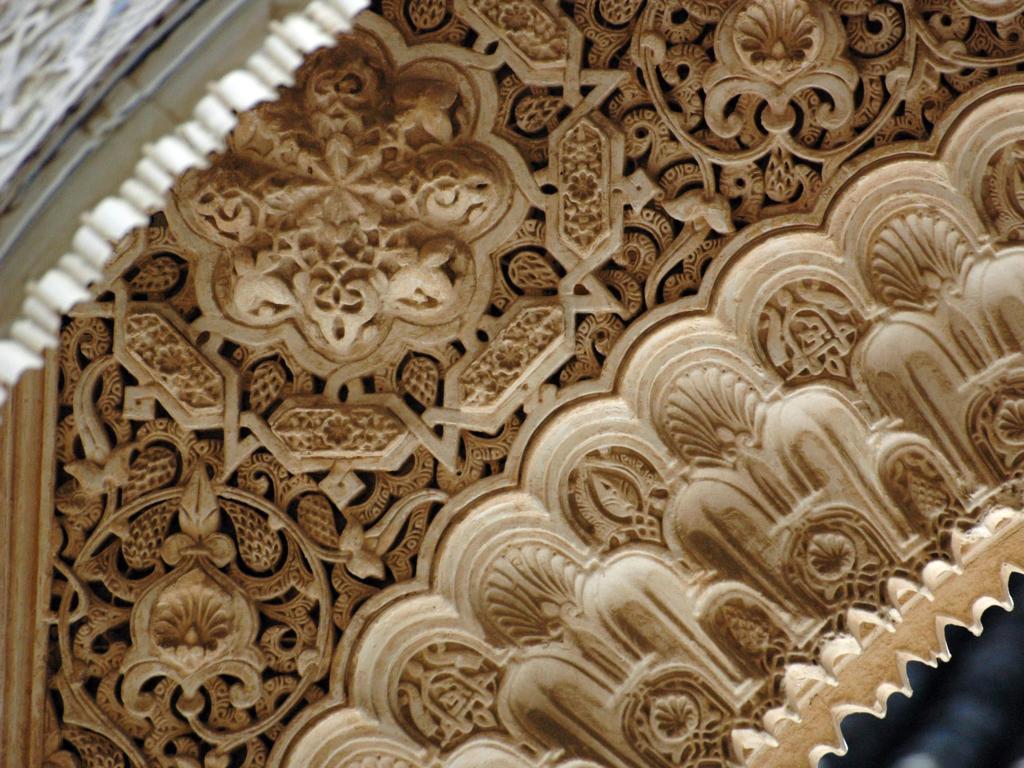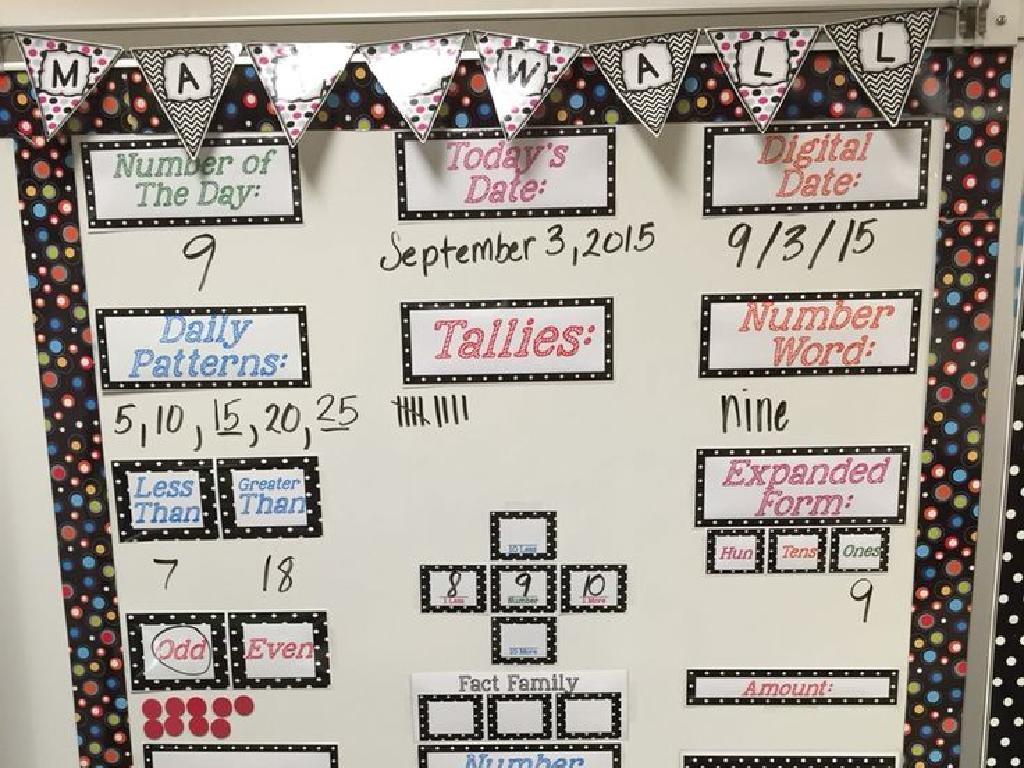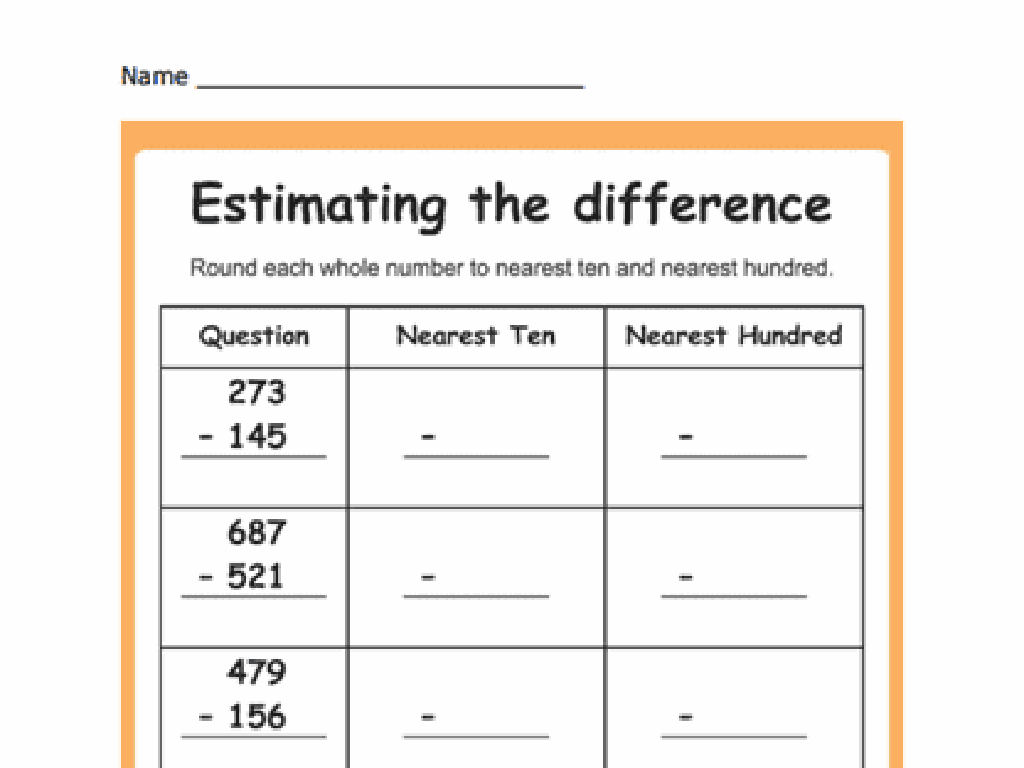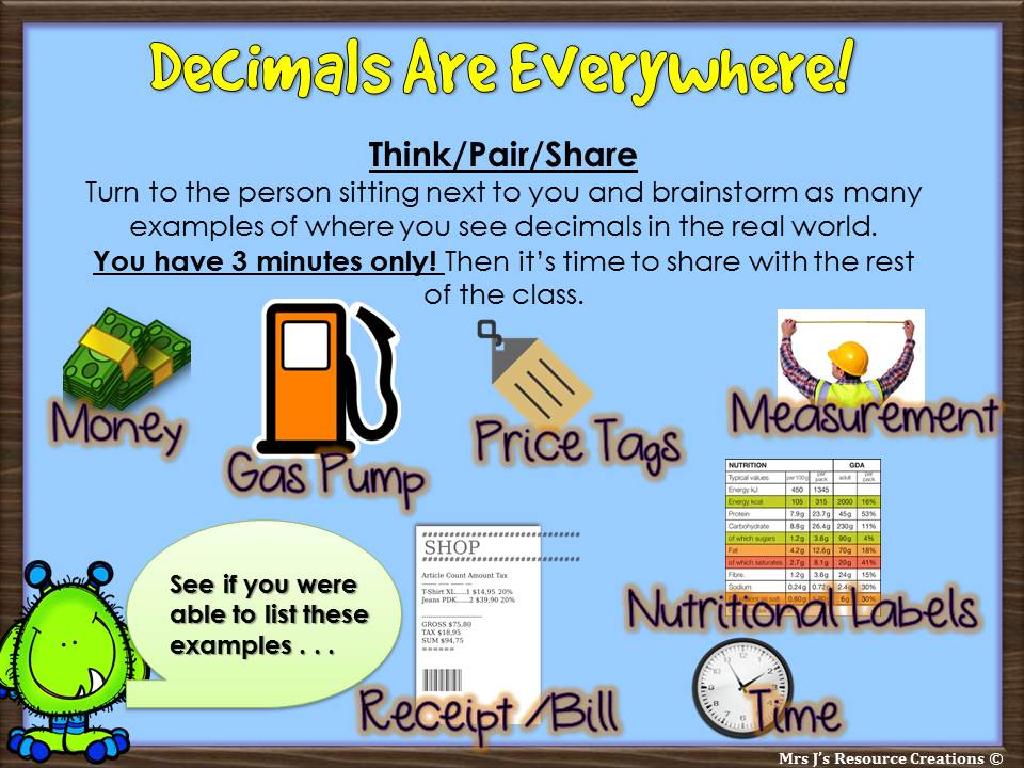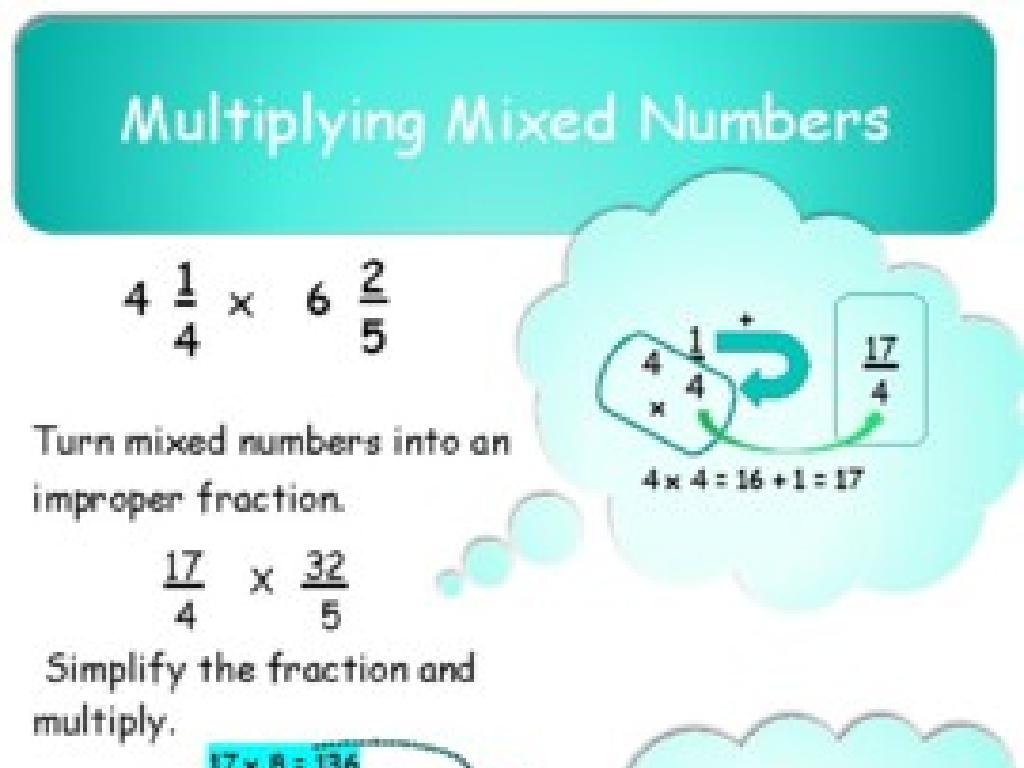Counting Tens And Ones - Up To 20
Subject: Math
Grade: First grade
Topic: Place Value
Please LOG IN to download the presentation. Access is available to registered users only.
View More Content
Welcome to Place Value!
– Learn about tens and ones
– Groups of ten are ‘tens’, single items are ‘ones’
– Understand numbers up to 20
– Numbers are made of tens and ones
– Counting with tens and ones
– Count by tens then add ones
– Practice counting to 20
|
This slide introduces the concept of place value to first graders, focusing on the tens and ones up to the number 20. Begin by explaining that numbers are made up of tens and ones – tens are like bundles of ten items, and ones are just single items. Use visual aids like blocks or drawings to show groups of ten and individual ones. Practice counting by tens (10, 20) and then adding ones to reach numbers in between (11, 12, … 19, 20). Engage the students with hands-on activities where they can group items into tens and ones to solidify their understanding. Encourage them to explain their counting process to develop their verbal math skills.
Understanding Place Value: Tens and Ones
– What is place value?
– Place value tells us the value of a digit in a number.
– Numbers have places: tens and ones
– The first place is ‘ones’, the next is ‘tens’.
– Grouping numbers into tens and ones
– We can make groups of ten to organize numbers.
– Counting with tens and ones
|
This slide introduces the concept of place value, which is fundamental in understanding how numbers are structured and how to count them. Explain that each digit in a number has a different value depending on its position, or ‘place’. The rightmost place is the ‘ones’ place, and the next to the left is the ‘tens’ place. Show how to group objects into tens and ones to visually represent numbers up to 20. For example, 15 is one group of ten and five ones. Use manipulatives like blocks or beads to help students visualize the grouping. Encourage students to practice by counting objects and arranging them into groups of tens and ones.
Counting with Tens
– Understanding ‘a ten’
– A ‘ten’ is a group of 10 items
– Counting by tens: 10, 20…
– We add 10 each time: 10, 20, 30…
– Practice with sticks or blocks
– Use objects to count in tens
– Recognize groups of ten
|
This slide introduces the concept of tens and how to count them, which is fundamental in understanding place value. Start by explaining that a ‘ten’ is simply a group of ten items, which can be anything from sticks to blocks. Practice counting by tens with the class, emphasizing the pattern that each number ends in a zero. Use physical objects like bundles of sticks or blocks to help students visualize and count in groups of ten. This tactile experience reinforces the concept of grouping in tens. Encourage students to recognize groups of ten in everyday life to strengthen their understanding.
Counting with Ones
– ‘Ones’ are numbers less than ten
– Single digits like 1, 2, 3… are ‘ones’
– Count ones without making a ten
– We use ones when we don’t have 10 items yet
– Practice counting: 1 to 9
– Let’s say them together: one, two, three…
– Understanding ones place value
– Ones are in the rightmost place in a number
|
This slide introduces the concept of ‘ones’ to first graders as part of understanding place value. Emphasize that numbers less than ten are referred to as ‘ones’ and are the building blocks of our number system. Use physical objects like blocks or counters to visually demonstrate counting up to nine, ensuring students understand that once we reach ten, we have a ‘bundle’ or a group, which is a different concept. Encourage the students to count aloud together and use their fingers to represent each number as they count. The goal is for students to recognize the pattern of counting and to become comfortable with the numbers that make up the ‘ones’ place value.
Combining Tens and Ones
– Combine tens and ones to make numbers
– Example: 1 ten and 5 ones make 15
– 10 + 5 = 15 shows how we add tens and ones
– Practice making numbers with tens and ones
– Use blocks or drawings to represent tens and ones
– Understanding place value up to 20
– Place value helps us see the value of digits in a number
|
This slide introduces the concept of place value by combining tens and ones to create different numbers up to 20. Start by explaining that numbers are made up of tens and ones. Use physical objects like blocks or drawings to help students visualize this concept. For example, show 1 group of ten blocks and 5 single blocks to represent the number 15. Encourage students to practice with different combinations of tens and ones to build various numbers. Reinforce the idea that the place of a digit in a number determines its value, with the rightmost place being ‘ones’ and the next place to the left being ‘tens’. This foundational understanding of place value is crucial for their future math skills development.
Let’s Practice Counting: Tens and Ones
– Fun worksheet activity
– Match numbers with tens and ones
– See how numbers break down into tens and ones
– Understand groups of 10 and single units
– 10 pencils vs. 1 pencil, 20 blocks vs. 2 blocks
– Practice leads to improvement
|
This slide introduces a classroom activity designed to help first graders understand the concept of tens and ones in a fun and interactive way. The worksheet will have illustrations of groups of ten items and single items, and the students will match the numbers to the correct group of tens and ones. For example, the number 15 would be matched to a group of ten pencils and five individual pencils. This activity reinforces the place value concept by providing a visual and hands-on approach to counting. Encourage students to discuss their matches and explain their thinking. As they practice, they will become more confident in their counting and understanding of place value up to 20.
Class Activity: Building Numbers with Blocks
– Build numbers using blocks
– Create numbers up to 20
– Each block represents one unit
– Tens are a bundle of ten ones
– Share your number creations
– Show and tell with classmates and teacher
|
This activity is designed to help students understand the concept of tens and ones through hands-on experience. Provide students with a set of blocks where each block represents one unit. Instruct them to create different numbers up to 20 by grouping the blocks into tens and ones. For example, to make the number 14, they would need one group of ten blocks and four single blocks. Encourage them to visualize the groups of ten as a bundle and the remaining blocks as ones. After building their numbers, students should present their block numbers to the class, explaining how many tens and ones are in their number. This will reinforce their understanding of place value and the concept of counting in tens and ones. Prepare to facilitate the activity by walking around the classroom, assisting students who may struggle, and ensuring that each student gets a chance to share their work.
Celebrating Place Value Mastery!
– Congratulations on learning tens and ones!
– Counting up to 20 with place value
– Each number has a place value, like 15 is 1 ten and 5 ones.
– Practice makes perfect – keep counting
– Try counting objects around you using tens and ones.
– Show your counting skills at home!
|
This slide is a celebration of the students’ achievement in understanding the concept of tens and ones in place value. Reinforce the idea that each digit in a two-digit number has a place and value, with the left digit representing tens and the right digit representing ones. Encourage students to continue practicing this concept outside of the classroom by counting various items they encounter in their daily lives, such as toys, snacks, or steps. This will help solidify their understanding and make them more confident in their counting abilities. Remember to praise their efforts and progress to boost their confidence.

